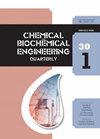Nitrogen Removal by HN-AD Bacteria Immobilized on Modified Absorbent Stone
IF 0.9
4区 生物学
Q4 BIOTECHNOLOGY & APPLIED MICROBIOLOGY
引用次数: 0
Abstract
How to simplify the nitrogen removal process, reduce the cost and improve the efficiency has become an urgent problem to be solved. In this research, the isolated HNAD (heterotrophic nitrification and aerobic denitrification) bacteria were used to remove the nitrogen in wastewater. Modified absorbent stone was used as high-efficiency and low-cost immobilized material. The modification effect was determined by the changes in mechanical strength, Zeta potential, pore structure, micrographs and biomass. The practicability of the modified carrier was further proved by experiments of environmental effect and reuse. The modified carrier had excellent performance. By comparing the degradation effects of immobilized microorganism and free microorganism, it was proved that the immobilized microorganisms have broad application prospects and strong adaptability to environmental factors. Under the optimum conditions (temperature of 30 oC, pH of 7, dissolved oxygen of 3.5 mg L–1), the removal efficiency of ammonia nitrogen reached 100 % in 40 hours, the removal efficiency of total nitrogen reached 60.11 % in 50 hours, and the removal rate of total nitrogen was 2.404 mg-NL–1 h–1 by immobilized microorganisms with the treatment of simulated nitrogen-containing wastewater. This research provides new material for the immobilization of HN-AD bacteria and a new way for nitrogen removal.改性吸附石固定化HN-AD菌脱氮研究
如何简化脱氮工艺,降低脱氮成本,提高脱氮效率已成为一个亟待解决的问题。本研究利用分离出的异养硝化好氧反硝化(HNAD)菌对废水进行脱氮。改性吸水石是一种高效、低成本的固定化材料。改性效果由机械强度、Zeta电位、孔隙结构、显微形貌和生物量的变化来确定。通过环境效果试验和重复利用试验,进一步证明了改性载体的实用性。改进后的载体具有优良的性能。通过对固定化微生物与游离微生物降解效果的比较,证明固定化微生物具有广阔的应用前景和对环境因子的强适应性。在最佳条件下(温度30℃,pH = 7,溶解氧为3.5 mg L-1), 40 h内氨氮去除率达到100%,50 h内总氮去除率达到60.11%,固定化微生物处理模拟含氮废水的总氮去除率为2.404 mg- nl - 1 h-1。本研究为HN-AD菌的固定化提供了新材料,为脱氮提供了新途径。
本文章由计算机程序翻译,如有差异,请以英文原文为准。
求助全文
约1分钟内获得全文
求助全文
来源期刊
CiteScore
2.70
自引率
6.70%
发文量
23
审稿时长
>12 weeks
期刊介绍:
The journal provides an international forum for presentation of original papers, reviews and discussions on the latest developments in chemical and biochemical engineering. The scope of the journal is wide and no limitation except relevance to chemical and biochemical engineering is required.
The criteria for the acceptance of papers are originality, quality of work and clarity of style. All papers are subject to reviewing by at least two international experts (blind peer review).
The language of the journal is English. Final versions of the manuscripts are subject to metric (SI units and IUPAC recommendations) and English language reviewing.
Editor and Editorial board make the final decision about acceptance of a manuscript.
Page charges are excluded.

 求助内容:
求助内容: 应助结果提醒方式:
应助结果提醒方式:


